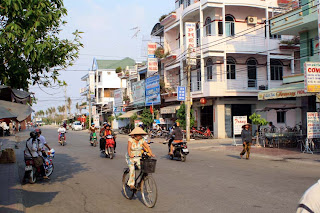Never mind. I shouldn’t complain. After all, I’m in Ho Chi Minh City, or Saigon as the Vietnamese still often call it, and it’s probably a very exciting place if you don’t confine yourself to a hot, stuffy hotel room in the backpacker district for days on end, trying to work up the enthusiasm to start thinking seriously about applying for jobs.
I got as far as preparing a CV, buying a Vietnamese sim card and studying TEFL websites intently. Then I realised that Hanoi in the north sounded more appealing (it’s cultured, reserved and actually gets cold!) and that, dash it all, I still have another month’s travelling in me.
Besides, I need to get back into a TEFL mindset before I arrange any interviews, so I'm going to move on from here tomorrow and refresh my memory of teaching over the next few weeks. Apparently May is a good time to apply for jobs in any case, as that's when the summer schools are starting.

So yeah, Ho Chi Minh City. A boom town. Very modern and capitalistic, but also friendly and quite low-pressure. I haven’t had a single cross word with anyone trying to sell me stuff in the street, although whether that’s down to the amicable environment or me feeling happier with myself, I can’t say.
In the past few days I’ve been to the Ho Chi Minh City Museum (dull), the Reunification Palace (kind of a 1960s office building, albeit with plusher rooms, an underground bunker and a couple of old tanks on the lawn), Notre Dame Cathedral (the number of churches in this country has surprised me, actually) and the Jade Emperor Pagoda (a quaint Chinese temple built about a century ago).
But predictably I suppose, the really interesting stuff relates to the Vietnam War, known over here as the American War. I was only a small child when it ended, so to me it’s always been something of a movie war: an historical event that I equate with the sort of Hollywood earnestness and histrionics so beautifully sent up by Ben Stiller in Tropic Thunder a little while back.

The War Remnants Museum has changed all that and made me determined to study the conflict more closely in future. Sure, some of it was heavily biased in favour of the North Vietnamese communists. That’s inevitable; history is written by the winners. However, the gut-wrenching display of photojournalism - much of it American - shocked and impressed me enormously.
The museum pulled no punches. There were photos of GIs blown to pieces. There were case studies of children born hideously deformed due to Agent Orange. And there was a chilling exhibit devoted to the My Lai massacre, which I’d heard of but never read about. Prior to this, I had no idea a US Army photographer had captured images of women, children and old men seconds before they were murdered by his colleagues. That stunned me. I assume the torture, gang rapes and disembowelling happened out of sight.

If anything, this place was more upsetting than the genocide museum in Phnom Penh. Indeed, there was a moment when I nearly lost it. Training my camcorder on an exhibit in one of the glass cases - an American serviceman‘s medals attached to small plaque - I read out the following inscription: “To the people of a united Vietnam. I was wrong. I am sorry.” The last word came out as a strangled sob.

Next day I went on a bus tour to Cu Chi, about 50km out of town, where guerillas based themselves in an astonishing network of tunnels they’d excavated using nothing more than hoes and wicker baskets.
First we were shown a black-and-white communist propaganda film from 1967 featuring amazing footage of the Vietcong in action here. After that, our guide showed us a tunnel entrance hidden in the jungle floor and took us around various exhibits designed to show us what life was like for the rebels.
What I’ll remember most vividly are the gruesome and highly ingenious booby traps laid for the Americans, usually involving holes in the ground, trapdoors, bamboo spikes, planks and nails. The last one our guide showed us was an upside-down wooden cross with six-inch nails sticking out, designed to swing down and impale a GI when he opened a door.
“If he was tall, these would stick in his heart,” he said, gesturing towards the higher-up nails. “These,” he added, pointing closer to groin level, “go somewhere else.” Pause. “No babies.” It was black humour, and I don’t think he meant it maliciously, but in that second my sympathies momentarily transferred to all those poor grunts who’d been sent here to do the politicians’ dirty work.
My journey into the rabbit warren was brief, hot and extremely cramped. Even though the section of the tunnels given over to tourists has been widened (as most foreigners tend to be larger than underfed Vietnamese peasants from the 1960s and 70s), it’s still desperately narrow and claustrophobic, prompting several members of my tour group to turn back just beyond the entrance.
I persevered for several minutes until a particularly narrow section gave me an excuse to use one of the numerous specially built exits. It took a good half an hour under an air vent on the bus to dry the sweat from my clothes, and I’m so glad I left a bundle of laundry with the guest house before I set out.
Oh guest house. Oh laundry service. Oh, those wonderful exits for the tourists.
Oh, how Vietnam has changed in 40 years… and oh my word, isn’t it marvellous.






























